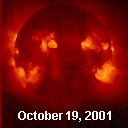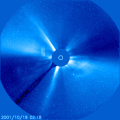|   SPACE WEATHER SPACE WEATHER
Current
Conditions
Solar Wind
velocity: 349.3 km/s
density:6.6 protons/cm3
explanation | more data
Updated: Today at 2245 UT
X-ray Solar Flares
6-hr max: M4 1650 UT Oct19
24-hr: X1 1630 UT Oct19
explanation | more data
Updated: Today at 2245 UT
Daily Sun: 19 Oct '01 
Active region 9661 has a twisted delta-class magnetic field that poses a threat for X-class eruptions. Sunspots 9658, 9669, and 9670 have beta-gamma magnetic fields that could unleash M-class flares. Image credit: SOHO/MDI
The Far Side of the Sun
This holographic image reveals no substantial sunspots on the far side of the Sun. Image credit: SOHO/MDI
Sunspot Number: 182
More about sunspots
Updated: 18 Oct 2001
Radio Meteor Rate
24 hr max: 21 per hr
Listen to the Meteor Radar!
Updated: 13 Oct 2001 Interplanetary Mag. Field
Btotal: 8.4 nT
Bz: 0.2 nT south
explanation | more data
Updated: Today at 2246 UT Coronal Holes:

There are no substantial coronal holes on the Earth-facing side of the Sun. Image credit: Yohkoh Soft X-ray Telescope.
More about coronal holes
 SPACE WEATHER SPACE WEATHER
NOAA
Forecasts
Solar Flares: Probabilities for a medium-sized (M-class) or a major (X-class) solar flare during the next 24/48 hours are tabulated below.
Updated at 2001 Oct 19 2200 UT
| FLARE | 0-24 hr | 24-48 hr | | CLASS M | 75 % | 75 % | | CLASS X | 20 % | 20 % |
Geomagnetic Storms: Probabilities for significant disturbances in Earth's magnetic field are given for three activity levels: active, minor storm, severe storm
Updated at 2001 Oct 19 2200 UT Mid-latitudes | 0-24 hr | 24-48 hr | | ACTIVE | 15 % | 55 % | | MINOR | 05 % | 30 % | | SEVERE | 01 % | 05 % |
High latitudes | 0-24 hr | 24-48 hr | | ACTIVE | 20 % | 55 % | | MINOR | 15 % | 30 % | | SEVERE | 05 % | 10 % |

Web server provided by
VPS Hosting
| What's Up in Space -- 19 Oct 2001
Subscribe to Space Weather News!  DOUBLE BLAST: On Friday, twisted magnetic fields above sunspot 9661 erupted powerfully -- not once, but twice -- at 0105 UT and again at 1640 UT. Both explosions unleashed category X1.6 solar flares and hurled lopsided coronal mass ejections (CMEs) toward Earth. The expanding clouds will likely strike Earth's magnetosphere on Oct. 21st and possibly ignite Northern Lights during this weekend's Orionid meteor shower. Above: This SOHO cornagraph animation shows Friday's first halo CME. A second one billowed away from the Sun approximately 16 hours later. DOUBLE BLAST: On Friday, twisted magnetic fields above sunspot 9661 erupted powerfully -- not once, but twice -- at 0105 UT and again at 1640 UT. Both explosions unleashed category X1.6 solar flares and hurled lopsided coronal mass ejections (CMEs) toward Earth. The expanding clouds will likely strike Earth's magnetosphere on Oct. 21st and possibly ignite Northern Lights during this weekend's Orionid meteor shower. Above: This SOHO cornagraph animation shows Friday's first halo CME. A second one billowed away from the Sun approximately 16 hours later.
HOT COMET: SOHO coronagraph images of Friday morning's CME reveal more than just solar activity: there's also a comet! You can see it in the full-sized movie as a faint dot at the 4:30 o'clock position moving toward the Sun. This comet -- discovered yesterday by Sebastian Hoenig -- is a "sungrazer."  METEOR ALERT: The annual Orionid meteor shower peaks this weekend. Sky watchers in either hemisphere who venture outdoors between 3 a.m. and dawn on Sunday morning will see 10 to 20 meteors per hour as tiny bits of debris from Halley's comet disintegrate in Earth's atmosphere. [full story] METEOR ALERT: The annual Orionid meteor shower peaks this weekend. Sky watchers in either hemisphere who venture outdoors between 3 a.m. and dawn on Sunday morning will see 10 to 20 meteors per hour as tiny bits of debris from Halley's comet disintegrate in Earth's atmosphere. [full story]
ZODIACAL LIGHTS: Autumn is the season for early morning Zodiacal Lights. Each day before dawn sky watchers with dark skies can spot a faint triangle of light above the eastern horizon caused by sunlight reflecting from interplanetary dust grains. Photographer Lyndon Anderson captured this image (below) of the Zodiacal Lights from a site near Bismarck, ND, on Oct. 17th. [gallery]  WEB LINKS: NOAA FORECAST | GLOSSARY | SPACE WEATHER TUTORIAL | LESSON PLANS | BECOME A SUBSCRIBER | 
Potentially Hazardous Asteroids (PHAs) are space rocks larger than approximately 100m that can come closer to Earth than 0.05 AU. None of the known PHAs are on a collision course with our planet, although astronomers are finding new ones all the time.
On 19 Oct 2001 there were 335 known Potentially
Hazardous Asteroids Oct. 2001 Earth-asteroid encountersNotes: LD is a "Lunar Distance." 1 LD = 384,401 km, the distance between Earth and the Moon. 1 LD also equals 0.00256 AU. MAG is the visual magnitude of the asteroid on the date of closest approach. 
- PERSEIDS 2001: Perseid watchers on August 12th spotted meteors, auroras, and a disintegrating Russian rocket! [gallery]
- MORNING PLANETS: In July and Aug. 2001, the Moon, Jupiter, Saturn, Venus, and Mercury put on a dazzling early-morning sky show. [gallery]
- C/2001 A2 (LINEAR): This volatile comet is still visible through small telescopes as it recedes from Earth. [gallery]
- ECLIPSE SAFARI: Onlookers cried out in delight on June 21, 2001, when the Moon covered the African Sun, revealing the dazzling corona. [gallery]
- TOTAL LUNAR ECLIPSE: On Jan. 9, 2001, the full Moon glided through Earth's copper-colored shadow. [gallery]
- CHRISTMAS ECLIPSE: Sky watchers across North America enjoyed a partial solar eclipse on Christmas Day 2000 [gallery]
- LEONIDS 2000: Observers around the globe enjoyed three predicted episodes of shooting stars. [gallery]
 July 27, 2001: Meteorites Don't Pop Corn -- A fireball that dazzled Americans on July 23rd probably didn't scorch any cornfields, contrary to widespread reports. June 12, 2001: The Biggest Explosions in the Solar System -- NASA's HESSI spacecraft aims to unravel an explosive mystery: the origin of solar flares. Feb. 21, 2001: Nature's Tiniest Space Junk -- Using an experimental radar, NASA scientists are monitoring tiny but hazardous meteoroids that swarm around our planet. Feb. 15, 2001: The Sun Does a Flip -- NASA scientists who monitor the Sun say our star's enormous magnetic field is reversing -- a sure sign that solar maximum is here. Jan. 25, 2001: Earth's Invisible Magnetic Tail -- NASA's IMAGE spacecraft, the first to enjoy a global view of the magnetosphere, spotted a curious plasma tail pointing from Earth toward the Sun. Jan. 4, 2001: Earth at Perihelion -- On January 4, 2001, our planet made its annual closest approach to the Sun. Dec. 29, 2000: Millennium Meteors -- North Americans will have a front-row seat for a brief but powerful meteor shower on January 3, 2001. Dec. 28, 2000: Galileo Looks for Auroras on Ganymede -- NASA's durable Galileo spacecraft flew above the solar system's largest moon this morning in search of extraterrestrial "Northern Lights" Dec. 22, 2000: Watching the Angry Sun -- Solar physicists are enjoying their best-ever look at a Solar Maximum thanks to NOAA and NASA satellites. MORE SPACE WEATHER HEADLINES |

